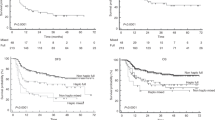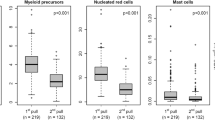Abstract
Tumour cell contamination of autologous peripheral blood stem cell samples (PBSC) and bone marrow (BM) is frequent. Enrichment of CD34+ stem cells is a promising approach to purging tumour cells from autografts without damaging progenitor cells. Breast cancer cells were seeded (10−3−10−7) into mononuclear cells from G-CSF-mobilised PBSC and BM harvests from patients without breast cancer. CD34+ cells were enriched from mixtures either by immunomagnetic separation (Isolex-50, and MiniMACS) or by biotin-streptavidin immunoaffinity columns (Ceprate-LC). CD34+ cell fractions were determined by FACS, cancer cells were detected immunocytochemically with an anti-pancytokeratin antibody. The CD34+ cells were enriched with a median purity of 92.2% (43.5–96.1) (n = 17) (Isolex-50), 96.5% (66.6–99.2) (n = 17) (MiniMACS) and 77.9% (31.4–93.6) (n = 15) (Ceprate-LC) from PBSC and BM harvests. The percentages of median recovery of CD34+ cells were 30.8% (18.6–71.8) (Isolex-50), 69.9% (39.1–100) (MiniMACS) and 42.9% (23.7–100) (Ceprate-LC). The median tumour cell reductions in log steps were 3.7 (2.9–4.3) (n = 13) (Isolex-50), 3.5 (2.6–4.3) (n = 13) (MiniMACS) and 1.5 (0.9–2.9) (n = 17) (Ceprate-LC). Results were compared statistically by univariate analysis. Purity was significantly (P < 0.05) better after minimacs selection. recovery rates were significantly different between all devices tested. tumour cell purging was superior after immunomagnetic separation (P < 0.001). tumour cell purging is a main objective of cd34+ selection in the autologous setting. Our in vitro data clearly indicate that immunomagnetic separation is more efficient in the prevention of accidental reinfusion of contaminating tumour cells compared to immunoaffinity. However, it is not yet known if the same results can be obtained with fresh contaminating tumour cells.
This is a preview of subscription content, access via your institution
Access options
Subscribe to this journal
Receive 12 print issues and online access
$259.00 per year
only $21.58 per issue
Buy this article
- Purchase on Springer Link
- Instant access to full article PDF
Prices may be subject to local taxes which are calculated during checkout
Similar content being viewed by others
Author information
Authors and Affiliations
Rights and permissions
About this article
Cite this article
Krüger, W., Gruber, M., Hennings, S. et al. Purging and haemopoietic progenitor cell selection by CD34+ cell separation. Bone Marrow Transplant 21, 665–671 (1998). https://doi.org/10.1038/sj.bmt.1701156
Received:
Accepted:
Published:
Issue Date:
DOI: https://doi.org/10.1038/sj.bmt.1701156
Keywords
This article is cited by
-
Ex vivo purging by adenoviral p53 gene therapy does not affect NOD-SCID repopulating activity of human CD34+ cells
Cancer Gene Therapy (2001)
-
Large-scale mobilization and isolation of CD34+ cells from normal donors
Bone Marrow Transplantation (2000)



